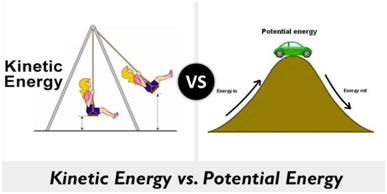Overview
The capacity to do work is called energy. Work is the transfer of energy. Energy can be transformed from one form to another. The unit of energy according to the International System of Units is Joule. Energy exists in two states. Kinetic energy: the energy of a body due to motion. The mathematical form of kinetic energy is K.E = 1/2 mv2. This shows the kinetic energy in a body of mass m and moving with velocity v. And potential energy: the stored energy is called potential energy. It can be gravitational: due to height and elastic potential: due to elasticity in body. The mathematical form of potential energy is P.E = m g h.
Definition of Energy
“A body possesses energy if it is capable to do work”.
Or
“Energy is defined as the capacity of a physical system to perform work”.
Energy is an essential and basic concept in science. It links almost all the natural phenomena. When we say that a body has energy, we mean that it has the capability to do work. Water running down the stream has the capability to do work, so it possesses energy.
The energy of running water can be used to run water mills or water turbines. Energy exists in numerous kinds such as mechanical energy, heat, light energy, sound energy, electrical energy, chemical energy and nuclear energy, and so on. Energy can be transformed from one kind into another.
SI Unit of Energy
The SI unit of energy is the joule (J) or newton-meter (N * m). The joule is likewise the SI unit of work.
Mechanical energy possessed by a body is of two types: kinetic energy and potential energy.

Kinetic Energy
The energy possessed by a body due to its movement is called it’s kinetic energy.
Explanation
Moving air is called wind. We can utilize wind energy for doing various things. It drives windmills and pushes sailing boats. Similarly, moving water in a river can bring wood logs through big ranges and can likewise be used to drive turbines for generating electrical power. Therefore, a moving body has kinetic energy, since it can do work due to its motion. The body stops moving as quickly as all of its kinetic energy is used up.

Mathematical Expression
Consider a body of mass m moving with velocity v. The body stops after moving through some range S due to some opposing force such as the force of friction acting on it. The body has kinetic energy and is capable to do work against opposing force F till all of its kinetic energy is consumed.
K.E. of the body = Work done by it due to movement
K.E = F S
vi= v
vf= 0
As F=ma
a = -F/m
Since motion is opposed by force like friction hence ‘a’ is negative.
2 a S = vf2– vi2
Now by putting values
2 (-F/m) S = (0)2 – (v)2
F S =1/2 mv2
Hence K. E= 1/2 mv2
This equation provides K.E possessed by a body of mass m moving with velocity v.
Potential Energy
The energy possessed by a body due to its position is referred to as its potential energy.
Explanation
Typically, a body has the ability to do work although it is at rest. For example, an apple on a tree is capable to do work as it falls. Thus, it possesses energy due to its position. The kind of energy which a body possesses due to its position is called its potential energy.
Types of Potential Energy
Gravitational potential energy
The energy present in a body due to its height is called gravitational potential energy.

Elastic potential energy
The energy present in a body due to its elasticity is called elastic potential energy.
Examples
Stored water possesses possible energy due to its height. A hammer raised as much as some height has the ability to do work since it has gravitational potential energy. A stretched bow has potential energy due to its extended position. When launched, the stored energy of the bow presses the arrow out of it. The energy present in the stretched bow is called elastic potential energy.
Mathematical Expression
Let a body of mass m be raised up through height h from the ground. The body will get potential energy equal to the work carried out in lifting it to height h.
Potential Energy:
P.E. = F x h
Here w = weight of the body, so the equation becomes
P.E. = w x h
As w = m g
So, P.E. = w h = m g h
Thus, the potential energy possessed by the body with respect to the ground is mgh and is equal to the work performed in raising it to height h.
